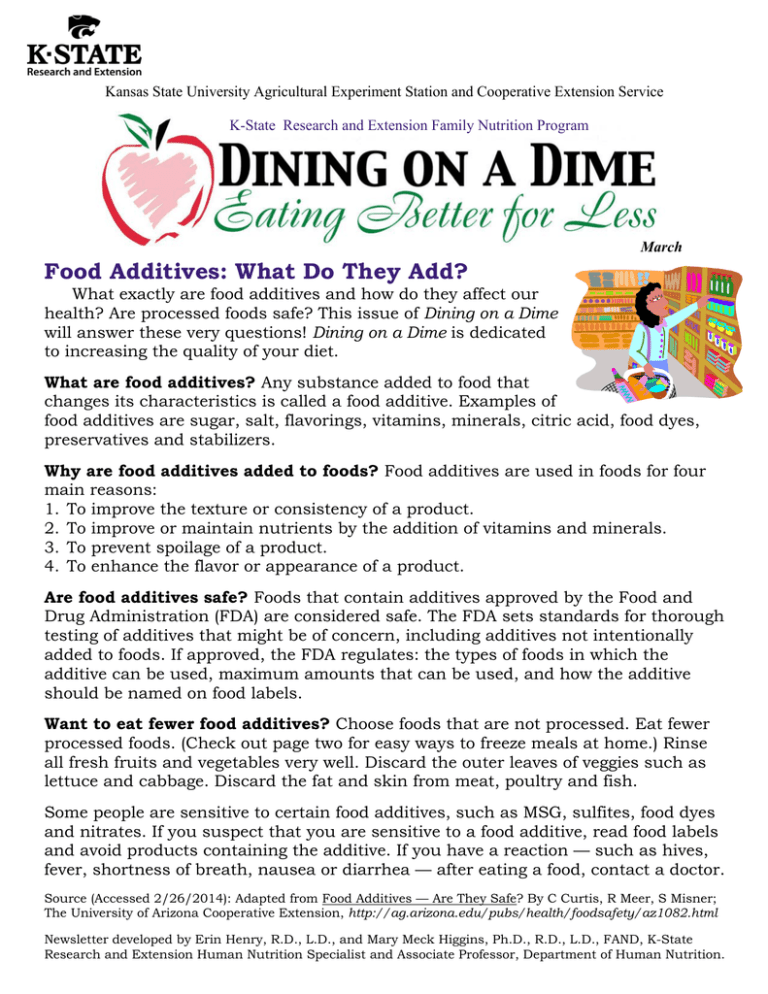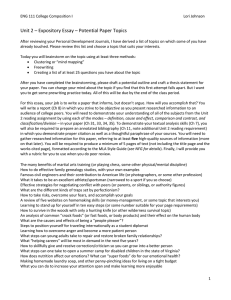Food Additives: What Do They Add?
advertisement

Kansas State University Agricultural Experiment Station and Cooperative Extension Service K-State Research and Extension Family Nutrition Program March Food Additives: What Do They Add? What exactly are food additives and how do they affect our health? Are processed foods safe? This issue of Dining on a Dime will answer these very questions! Dining on a Dime is dedicated to increasing the quality of your diet. What are food additives? Any substance added to food that changes its characteristics is called a food additive. Examples of food additives are sugar, salt, flavorings, vitamins, minerals, citric acid, food dyes, preservatives and stabilizers. Why are food additives added to foods? Food additives are used in foods for four main reasons: 1. To improve the texture or consistency of a product. 2. To improve or maintain nutrients by the addition of vitamins and minerals. 3. To prevent spoilage of a product. 4. To enhance the flavor or appearance of a product. Are food additives safe? Foods that contain additives approved by the Food and Drug Administration (FDA) are considered safe. The FDA sets standards for thorough testing of additives that might be of concern, including additives not intentionally added to foods. If approved, the FDA regulates: the types of foods in which the additive can be used, maximum amounts that can be used, and how the additive should be named on food labels. Want to eat fewer food additives? Choose foods that are not processed. Eat fewer processed foods. (Check out page two for easy ways to freeze meals at home.) Rinse all fresh fruits and vegetables very well. Discard the outer leaves of veggies such as lettuce and cabbage. Discard the fat and skin from meat, poultry and fish. Some people are sensitive to certain food additives, such as MSG, sulfites, food dyes and nitrates. If you suspect that you are sensitive to a food additive, read food labels and avoid products containing the additive. If you have a reaction — such as hives, fever, shortness of breath, nausea or diarrhea — after eating a food, contact a doctor. Source (Accessed 2/26/2014): Adapted from Food Additives — Are They Safe? By C Curtis, R Meer, S Misner; The University of Arizona Cooperative Extension, http://ag.arizona.edu/pubs/health/foodsafety/az1082.html Newsletter developed by Erin Henry, R.D., L.D., and Mary Meck Higgins, Ph.D., R.D., L.D., FAND, K-State Research and Extension Human Nutrition Specialist and Associate Professor, Department of Human Nutrition. Page 2 A Guide to Freezing Foods at Home Eating fewer processed foods can save you money. It can also increase the quality of your diet. Use your freezer to help! Freezing allows you to safely store food purchased in bulk or on sale. And when you freeze a casserole or soup, you will have a readymade meal that’s only a warm-up away. But... Some foods freeze worse than others. For instance, raw fruits and vegetables that have lots of water, such as lettuce, celery and cucumbers, are usually mushy when thawed. The following list shows foods that do not freeze well. Keep these out of your freezer, so that you don’t have a “freezer flop.” Do not freeze casseroles or soups containing these foods: Cooked eggs Sauces and gravies Yogurt and sour cream Raw eggs in the shell Fried foods Pasta Custards and cream puddings Mayonnaise Pie meringues Cooked potatoes chunks, such as potato salad Crumb toppings Cake icings with egg whites Some of the foods listed are available in commercially frozen versions with good quality. How? Food companies have equipment that freezes food faster than home freezers do. Also, companies may use food additives that help prevent frozen foods from breaking down. These ingredients aren’t usually available to home cooks. It’s time to chill: Ideas for quickly freezing foods Cool hot foods in shallow containers on a cooling rack for 20 minutes, then in a refrigerator. Cool in the refrigerator completely before freezing them. Freeze in meal-sized packages. If quick thawing is important to you, use containers that are thin and flat. Label each package with the contents and the date that you froze it. Pack foods fairly tightly into containers specifically made for freezing foods and that are the right size for the amount of food. If using freezer bags, press out excess air. Leave about 1/2 inch of space between the food and the freezer package closure to allow the food to expand as it freezes. Seal the package tightly. If freezing several packages at once, leave a little space between them so that air can circulate and they will freeze faster. Move them closer together after they’re frozen. A food has “freezer burn” when its surface is too dry. It is safe to eat, but its quality is lower. Prevent freezer burn by using the ideas shown above and by limiting the number of weeks that you store the food. Thaw perishable foods in leak-proof containers in a refrigerator. Source (Accessed 2/26/2014): Consumer Food Safety Checklist for “Planned-over” Foods. By A. Henneman, J. Jensen; University of Nebraska Cooperative Extension, www.lancaster.unl.edu/food/checklistplannedover.pdf You may view previous newsletters at www.ksre.ksu.edu/HumanNutrition/p.aspx?tabid=184 This issue is an updated revision of the “Dining on a Dime February 2006” newsletter. Contents of this publication may be reproduced for educational purposes. All other rights reserved. In each case, credit Erin Henry and Mary Meck Higgins, “Dining on a Dime,” March 2014. Page 3 Fiber in Your Diet — Start Roughing It! Dietary fiber is also called “roughage.” It provides health benefits to people of all ages. Fiber helps you feel full, helps food digest, keeps bowel movements soft, and may decrease your risk for obesity, heart disease and type 2 diabetes. Adults should try to get 14 g of fiber for every 1,000 calories eaten. Usually this would amount to about 25 to 38 g of dietary fiber every day. You can calculate a child’s fiber needs by the “age + five rule.” For example, a 7 year-old would need 7 + 5 = 12 g of dietary fiber per day. Most people would benefit from choosing foods with more fiber, such as cooked dry beans and peas, other vegetables, whole grains, nuts and fruits. Read the Nutrition Facts labels on your favorite foods to see how much fiber they have. Bran cereals, for instance, vary a lot in fiber content depending on the brand. The list below shows common foods and their fiber content. How does your plate rate? Food Fiber, g Food Fiber, g Navy beans, 1/2 cup 9 Whole wheat cereal, 1 ounce 4 Black beans, 1/2 cup 8 Mashed sweet potatoes, 1/2 c 4 Kidney beans, 1/2 cup 8 Green beans, 1/2 cup 3 Split peas, 1/2 cup 8 Apple with peel, 1 medium 3 Chickpeas, 1/2 cup 8 Raisins, 1/4 cup 2 Lentils, 1/2 cup 8 Banana, 1 medium 2 Pinto beans, 1/2 cup 8 Whole wheat bread, 1 slice 2 Refried beans, 1/2 cup 6 Orange, 1 small 2 Baked beans, 1/2 cup 5 Cooked carrots or corn, 1/2 cup 2 Green peas, 1/2 cup 4 Cereal bar w/ fruit, 1 bar 1 Popcorn seeds, 1 ounce 4 Fruit juice, 1 cup Cooked oatmeal, 1 cup 4 Meats and dairy products Less than 1 0 Ideas for increasing your daily dietary fiber Add bran cereal, rolled oats, prunes or raisins to your favorite cookie, pancake, muffin or quick bread recipes. Add cooked dry beans or peas, seeds or nuts to your salads, stir-frys or soups. Use whole grain flour when baking. Using half whole grain and half white flour will change the texture of products only slightly. Sources (Accessed 2/26/2014): 1. USDA’s Dietary Guidelines for Americans 2010, www.cnpp.usda.gov/ Publications/DietaryGuidelines/2010/PolicyDoc/Chapter4.pdf 2. USDA’s National Nutrient Database, http:// ndb.nal.usda.gov/ndb/nutrients For more information about healthy eating, contact your local extension office. This material was funded by USDA’s Supplemental Nutrition Assistance Program. The program can help people of all ages with low income buy nutritious foods for a better diet. To find out more, call 1-888-369-4777. Dining on a Dime’s Cooks’ Corner Apricot Oatmeal (Makes 3 servings, each about 2/3 cup) If desired, use a mixture of your favorite dried fruits. Ingredients 1/2 cup chopped dried apricots, raisins or other dried fruit 1/2 teaspoon ground nutmeg or cinnamon 1/2 cup unsweetened apple juice 1 cup water Cooperative Extension Service 1/2 cup uncooked quick-cooking oats K-State Research and Extension Apricot-flavored yogurt, if desired Directions 1. Combine fruit, spice, juice and water in a saucepan with a lid. Cover and heat to boiling. Reduce heat and simmer for 8 minutes, or until fruit is tender. 2. Stir in oats. Cook uncovered for about 2 minutes, stirring occasionally, until thickened. 3. Spoon mixture into three serving bowls. If desired, top with yogurt. 4. Cover and refrigerate leftovers promptly. Nutrition Facts: Each serving (without yogurt) provides 130 calories, 1g fat, 0g saturated fat, 0g trans fat, 29g carbohydrates, 3g protein, 0mg cholesterol, 20mg sodium and 3g dietary fiber. Daily Values: 6% vitamin A, 0% vitamin C, 4% calcium, 8% iron. K-State, County Extension Councils, Extension Districts, and the U.S. Department of Agriculture cooperating. K– State is an equal opportunity provider and employer.




